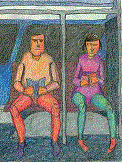|
|
 |
.

|
|
|
 |
.

|
| main index | short story index |
| Thanks to my older brother, John O'Connor's notes, I was able to weave this story of my paternal great grandmother's close encounter with death. So close, as to cause me wonder and speculation, with regard to the luck of my existance. |
| Night of the Big Wind
Jan 6-7 1839 She was born in the year 1838 into a stone-walled thatched- roofed hut on a stormy coast just north of Wexford Ireland and began life with the name: Bridget. The "hut"was the name used by my grand-aunt Adelia O'Connor, as told to her, by her mother "Bridget". The hut that Bridget was born into, sat toy-like at the back of nature's landscaped step looking out to the Sea towards Wales. It was protected by a steep incline at the back and a few hundred yards from the front door, another steep incline looked down on the shore of the Irish Sea. People lived mostly on fish - one of my favorite snacks. The enjoyment of the one I call " my little fishes"- sardines - has been passed down to me from my great-grandparents, from a far-away time, in a far-away land. In the night January 6 - 7, 1839, a wind blew over Ireland with such force and duration that it was recorded in history and folklore memory as, "the big wind of 1839". On the coast, my great-grandmother's little hut put up a valiant front against the spray, from the wave tops in the Irish Sea, caught up by the ferocious howling wind that riveted the spray against the stone-walled thatched-roofed little hut. The high pressure mixture of wind and spray ripped inland like chain-saws, sparing nothing in their path. Inside the little hut, Bridget had been constantly awakened by the howling screeching wind. These were new sounds, not part of the normal sounds in her predictable world. She could feel her body convulsing as it had done earlier, the soreness in her throat from the convulsive screaming to stop the noise in her ears. Suddenly from the darkness she could feel herself being picked up and cuddled against a familiar warm body but she still couldn't stop crying. My great-great-grandmother - Bridget's grandmother - had just gotten Bridget to sleep when, with a sudden intensification of the wind, the baby began to scream convulsively. Her grandmother went to the nursery, picked up Bridget from her crib, carried her back into the hearth room, with its great cooking-fireplace. She managed to once more calm Bridget by holding her close to her own body and singing and rocking her. Bridget could feel the vibrations of her grandmother's singing and the soft inviting comfort of her breasts - feel the rhythm of her beating heart - feel the firmness of her rib cage. Bridget's infant body once more felt part of a shared body - no longer alone - once more being allowed to flee the separateness of birth and within the nurturing of that oneness, the howling screeching wind faded from her consciousness as she moved into another world from which she could watch the flickering flames dancing in the great fire place of the hearth room. A sudden loud noise startled her and brought her back to the now world of her birth, to face the full force of the howling screeching wind that tore at her ears and face threatening to take her breath away. A stone boulder from the steep incline at the back of the hut had been loosened by days of the pounding wind and spray. The boulder came crashing through the thatched roof, crushing the crib where Bridget - my great-grandmother - had lain moments before. One arm of the invading wind pushed Bridget and her grandmother against the wall of the hut. The other arm of wind tore through the rest of the roof scattering the thatch for miles. Holding Bridget close to her chest, her grandmother
fought against the biting pushing wind that whirled round inside
the hut and reached the door of the old family cave. The cave
had been dug into the side of the cliff as protection from the weather
before the hut had been built. After the family built the hut, it
had been used as a root cellar for many decades. But now, it offered
a dry, quiet womb within the cliff. There, in the family's original
shelter, together as one, Bridget and her grandmother would wait
out the big wind of 1839.
Keith O'Connor
I will take this opportunity to thank my oldest
brother John O'Connor for keeping notes of this story, told to him
by his grand aunt Adelia of her mother Bridget. I would also thank
my patient wife Sharon O'Connor for her excellent editing skills.
|
